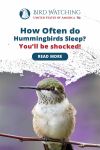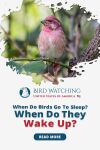
What’s this Post About?
After the long, exhausting search for food, hummingbirds tuck themselves in for the night and call it a day. The question that usually arises when monitoring these little birds is, how do they manage to have ample energy for a full day’s flight, every single day?
People usually wonder how often do hummingbirds sleep because they have a unique sleeping pattern. Unlike other birds, hummingbirds are accustomed to a sleeping state about which you just really want to know more about.
Hummingbirds sleep every day at night or sometimes in the day in a state known as torpor. They save up all their energy during their self-induced, coma-like sleep, to use it for daytime hovering. During this all-night hibernation, they are unstirred by any external stimuli that they almost seem, dead.

How Often Do Hummingbirds Sleep?
Hummingbirds sleep at night and sometimes take a nap in the day. Their sleep is known as torpor in which their bodies slow down and conserve energy. They make skip on sleep in certain circumstances like when they are migrating long distances.
Hummingbirds and Their Sleeping Patterns
Hummingbirds have a lower caloric intake compared to their energy expenditure. Moreover, they also have a high metabolism, which is why hummingbirds have a hard time keeping up with the amount of food that their little bodies need.
To combat this, hummingbirds save their nighttime energy, for the day. This requires them to have a very low energy-consuming sleeping pattern.
Generic sleeping patterns require temperature and regular breathing pattern maintenance. This requires a ton of energy that hummingbirds cannot spare.
For this reason, hummingbirds, have a unique way of sleeping, called the torpor, a hibernation-like state, but in some ways, also not like hibernation.
Read on to learn more.
The Hummingbird Metabolism
The tiny hummingbird has a rapid metabolic rate.
You will be shocked to know how fast a hummingbird’s metabolism is. It is just incredible. One thing we know for sure is that hummingbirds are constantly on the move.
They are always flying from one place to the other with little rest, flapping their wings at great speed. No wonder these tiny beautiful birds are exhausted by the end of the day.
To put things into perspective, let’s see why a hummingbird’s metabolism is so fast:
-
A hummingbird has a heart rate of 1260 beats per minute!
-
They take about 250 breaths per minute at rest. This may increase during flight.
-
Per flight, their wings beat about 53 times!
This is exactly why these birds have such a unique way of sleeping. It also explains the answer to the common question of many bird lovers of how often do hummingbirds sleep.
Did You Know?
Hummingbirds drink nectar from feeders by moving their tongue in and out 13 times per second! They can eat up to double their body weight in a day!

How Do Hummingbirds Prepare for Sleep?
Early to bed - Early to rise!
Hummingbirds prepare for sleep by looking for a sleeping spot half an hour before they actually sleep. They are aware when nighttime is approaching and do things accordingly.
Hummingbirds are somewhat unique in the way they prepare for sleep. Unlike most other animals, hummingbirds don’t take long to settle in.
They usually pick up the pace to turn in for the night during the evenings. Hummingbirds can easily tell when nighttime is approaching.
To select the right place, hummingbirds are not at all picky. As long as the place is safe and will not attract the attention of any sort, hummingbirds won’t have a problem sleeping there.

Such places usually include tree branches. Mothers will usually fly back to their nests whereas the non-mothers imitate bats, perched upside down on tree branches, during the night.
Hummingbirds begin about 30 minutes before nightfall to look for a suitable place to settle in, just before the sunsets completely.
What is Torpor?
A Coma-like Snooze.
During torpor, hummingbirds are almost dead. They are unable to respond to any external stimuli and their body shifts to a lower energy expenditure. Their heartbeat drops to 50 beats per minute, as opposed to 1260 during the day and their metabolism drops down to 1/15th of what it is otherwise.
The internal processes of hummingbirds require a large amount of energy to function. If these processes continue during the night as well, most hummingbirds would need more fuel, just to keep themselves warm and maintain their breathing pattern.
For this, mother nature seems to have a solution. Hummingbirds adopt a sleeping pattern that allows them to conserve this energy by going into hibernation. This self-induced nightly hibernation is called Torpor.
Torpor isn’t usually a long sleeping process. Hummingbirds are usually up and about early in the morning. However, the sleep itself is fascinating.
After all, it causes a range of changes in the body of a hummingbird. Their body temperature also decreases at night. This can be about a 50-degree drop from the daytime. In total, hummingbirds end up using only 5 to 30% of their total energy at night, helping them save about 65% to 90% of it. Interesting, isn’t it?

Did You Know?
Weaker hummingbirds are sometimes unable to survive torpor. They die in their sleep!
Why is Torpor Important?
Torpor is important as it helps hummingbirds survive the night without dying because of starvation. It helps them conserve energy, maintain their temperature and deal with their high metabolism.
To summarize, there are three things that make torpor vital for hummingbirds:
-
Helps maintain temperatures during cold nights
-
Helps conserve energy, and maintain bodily function, even with lower levels of caloric reserve
-
Helps combat their high metabolism
Waking Up
After a full night’s rest, hummingbirds wake up at dawn. The process of leaving the state of torpor takes about 30 minutes to 1 hour for most hummingbirds. This is only fitting, as it takes almost the same time for hummingbirds to enter the state of torpor. It makes sense that it takes them some time to come out of the state as well.
At the time that hummingbirds wake up, their heartbeat begins to increase and their breathing patterns go back to normal.
As the heart rate goes back up, hummingbirds begin to vibrate. This is to generate heat within the body as the blood begins to circulate, raising body temperatures to a steady regular.
Before you know it, hummingbirds are ready for their next flight, in search of food. A hummingbird’s first meal of the day is very important, it helps regulate body function and fulfills caloric intake for their rapid metabolism.
Hummingbirds have about 1/4th of their daily intake during the first meal.
Some Exceptions
Migrations and Late-Night Binges
Though these sleeping patterns are typical to most hummingbirds, there are some instances in which you might find the situation a little different:
-
During the warmer climates, we might see hummingbirds feeding during the night to maintain energy requirements. Keep the lights on at night in your backyard and you might just find them!
-
Hummingbirds on migration might just skip the torpor altogether as they require a 20-to-24-hour flight during this season
Did You Know?
Hummingbirds are the only birds that can fly backward!

Keep Reading!
After having read through how often and how do hummingbirds sleep, wouldn’t you agree that they are unique? It is fascinating to observe that these small hummingbirds go through such heavy, opposing changes every day and night. Such changes, even us humans cannot sustain in our bodies.
The torpor is a perfect hibernation-like state, best suited for these magnificent birds. There is so much to learn about these creatures, it’s beguiling. If you’d like to know more about hummingbirds and whether feeders are bad for them, read our post.
Are Hummingbird Feeders Bad for Hummingbirds? Find Out Fascinating Facts
Have you ended up here searching 'are hummingbird feeders bad for hummingbirds'? If yes, then you're at the right place. Continue to read on.

By David A. Swanson
Bird Watching USA
My name is David and I'm the the founder of Bird Watching USA! I started Bird Watching with My father-in-law many years ago, and I've become an addict to watching these beautiful creatures. I've learnt so much over about bird watching over the years that I want to share with the world everything I know about them!

David A. Swanson
Bird Watching USA
My name is David and I'm the the founder of Bird Watching USA! I started Bird Watching with My father-in-law many years ago, and I've become an addict to watching these beautiful creatures. I've learnt so much over about bird watching over the years that I want to share with the world everything I know about them!



![Pigeons Sitting Down - Why Do They Do It? [12 Funny Photos] Thumbnail](/assets/resized/img/posts/pigeons-sitting-down-100x150.jpg)


![Pigeons Sitting Down - Why Do They Do It? [12 Funny Photos] Thumbnail](/assets/resized/img/posts/pigeons-sitting-down_thumbnail-100x56.jpg)


